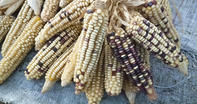Here’s How it Works
Let’s start with the carbon cycle. Carbon is one of the main building blocks in our universe. On Earth, it shifts constantly from the atmosphere, to organic matter such as trees or animals, dissolves in water or is stored away in the soil, and then released back into the atmosphere in a perpetual cycle.

Carbon dioxide, the gaseous shape it takes in our air, is breathed in by plants. Being the food factories that they are, plants convert the carbon to carbohydrates, fats and proteins which they then use to build their stems, leaves, seeds and fruits. Plant eating animals graze the greens and convert these into muscles, skin, organs.
Think of a plant or animal as the loose change in your pocket. When it dies and rots, or is burned, it releases that carbon back into circulation. The ocean also strips carbon from the atmosphere, and does so in two ways: organically, phytoplankton convert carbon to carbohydrates, much the way land-based plants do, and redirect it into the marine food chain.
An inorganic process also happens. Wherever atmosphere touches ocean, some CO2 is dissolved into the water and gets mixed down through the water columns.
Carbon Sinks

These land-based and ocean-based carbon “sinks” help scrub carbon from the atmosphere. Sometimes, though, it can be banked away for much longer. About 350 million years ago, towards the beginning of the Carboniferous Period, Earth was warm and wet. Many of its forests grew in vast swampy environments around the planet.
When these trees died, they were covered over with water and soils and prevented from rotting in the open air. After millions of years, with more and more rock and dirt building up over these layers of trapped wood, heat and pressure turned them to coal. Similar processes were happening on the ancient sea floor, where organic matter was trapped and formed into oil and liquid gas over millions of years. Think of this as the long-term savings in the bank.
Naturally, if these long-term carbon banks are dug up and burned, the carbon is put back up into the atmosphere, shifting the equation towards one with more atmospheric greenhouse gases and more heat-trapping potential. Since the transport sector is dependent on ancient fossil fuels to operate, with all the associated price fluctuations, and complex politicking which occasionally even erupts into war, the idea of moving away from dependence on fossil fuels sounds like a good idea.
Why draw more capital out of the bank, when you can just keep the small change circulating? Instead, take a mealie, which drew carbon from the atmosphere last summer while it grew, and burn it in your petrol engine, releasing its carbon back into the atmosphere. Round and round it goes in a neat, nearly-closed loop.
Good Ideas Gone Wrong
The main types of these “carbon neutral” or low carbon biofuels are biodiesel, where plant oil is blended with normal petroleum diesel, and bioethanol made from the fermented sugars in maize, sugar cane and sugar beet as an alternative to petrol. This is the logic behind biofuels.
And it sounded like such a good idea that in Indonesian, loggers began tearing down vast swathes of jungle to make room for palm oil plantations. Conservationists were horrified, telling The Guardian newspaper that not only was this an immediate threat to the survival of the orangutan, Sumatran tiger and the Asian elephant, but that promises of a palm oil industry were just being used as a cover for something far more sinister.
They were a smokescreen to allow access to the “last stands of timber not already lost to illegal loggers” and that hardly any palms were being planted in the newly felled areas. Clearing areas like this to make way for palm monocultures also required drying out and burning extensive peat fields, which are packed to the gills with stored carbon, making this palm oil industry anything but carbon neutral.
Mythical Green Fuels
But now it seems that any notion of green fuels being carbon neutral or even low carbon is nothing short of mythical. With market demand worldwide driving up the price of crops for biofuel, farmers are converting more and more land to agriculture through ploughing or clearing natural veld, wetlands or forests, processes which release vast amounts of soil-stored carbon into the atmosphere.
Where this was being done in Brazil, Southeast Asia and the United States, the journal Science reported in February 2008, this was leading to the release of “17 to 420 times more CO2 than the annual greenhouse gas (GHG) reductions these biofuels provide by displacing fossil fuels”.
This creates a carbon “debt” that could not easily be paid back by the carbon “savings” created by those very biofuels. Where natural veld is cleared worldwide to grow crops for ethanol, this could result in a doubling of carbon emissions over 30 years, another article in the same issue of Science states. “Biofuels from switchgrass, if grown on US corn lands, increase emissions by 50%.” Instead of ploughing up virgin land, the journal argues, rather look elsewhere for biofuels.
Agriculture produces huge amounts of “biomass” or organic waste that can be used for creating biofuels. Perennial crops, in particular, “incur little or no carbon debt and offer immediate and sustained (greenhouse gas) advantages”.
By Leonie Joubert